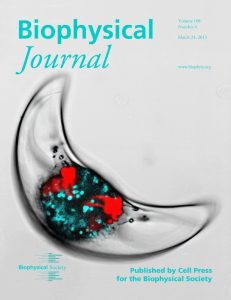 We have published a new paper in which we use dinoflagellate bioluminescence as an indicator of the response to mechanical stimuli. The full text article includes a movie as supplemental material.
We have published a new paper in which we use dinoflagellate bioluminescence as an indicator of the response to mechanical stimuli. The full text article includes a movie as supplemental material.
The cover image for the journal issue highlights our study, which we describe in an accompanying blog post. This study is interesting because it uses a sophisticated instrument, the atomic force microscopy, to apply precise mechanical stimuli to single dinoflagellate cells. The natural bioluminescence of dinoflagellates serves as an indicator of cell response to the mechanical stimuli. By varying the parameters of the applied stimuli, we determined that the viscoelastic properties of the cell explained the velocity dependent cell response. We are interested in dinoflagellate bioluminescence because it is a rapid but complex mechanosensing system that may have conserved elements that are used in mechanosensing by higher organisms including humans. Further study will ‘shed light’ on the evolution of mechanosensing in simple organisms. The work was done with former SIO postdoc Benoit Tesson, who is now working in France. For more information about the study, see the article in SIO Explorations, the online magazine of Scripps.
